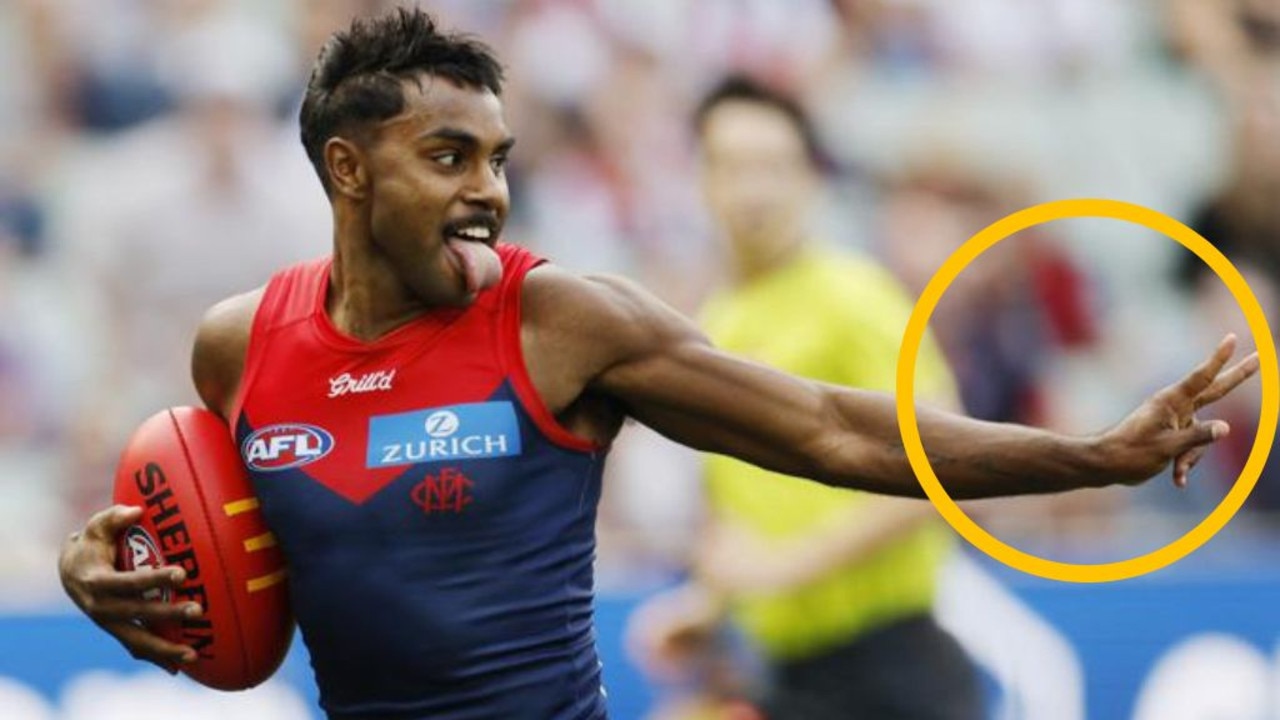Mick Fanning puts dark days behind him
CHAMPION Aussie surfer Mick Fanning is putting the 10 long seconds when he was attacked by a shark — and a terrible year — behind him.
Sport
Don't miss out on the headlines from Sport. Followed categories will be added to My News.
MICK Fanning calls them “blobs”. He spends a lot of time staring at his computer or his iPad, depending on where he is, looking for the right sort of blob, and then goes after it.
To the uninitiated, those “blobs” are weather systems; the perfect combination of oceanic conditions — winds, low-pressure systems and the like — which create swells surfers like Fanning can, almost on a whim, chase down.
Either in his back yard or across the globe, if the blobs are big enough, Fanning has the capability to drop everything and get to them.

He was at home on the Gold Coast two weeks ago with his mate, photographer Corey Wilson, mad keen for a surf while he enjoyed his year off the fulltime tour.
He’s having some “Mick time” for 12 months, after a massive 2015. So far he’s been on a surfing safari to Alaska of all places, with a few more trips to come.
But he was at home for a while, and there was nothing happening locally. No waves.
So he turned to his computer and found a couple of “big old blobs” headed towards the South African coast. The southeast coast.
They were headed to Jeffrey’s Bay, where the perfect right-hand point break wave rolls into a wild coastline which is settled in spots but untamed for hundreds of kilometres, including either side of J-Bay, as surfers know it.
It’s some sort of theatre to take in, a first sighting of the African coast from the sand at J-Bay where the Indian Ocean takes off to the horizon, uninterrupted until it gets to Western Australia.
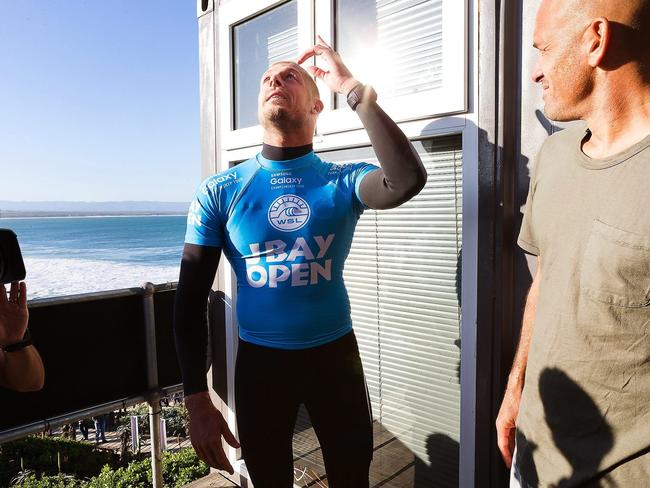
It’s what Fanning calls a “bucket-list” destination, the best wave of its kind in the world, where they roll in one after the other, metronomic for most of the year.
In July, it’s the destination for the best surfers on the planet, hosting a round of the World Surf League, the J-Bay Open.
Fanning, who has just turned 35, loves the place. The people, the local surfing community and the wave.
He first won the J-Bay Open in 2002. He’s been surfing there for 15 years as a pro, and a few before that.
That’s thousands of waves surfed there — pleasure levels at a high every time he paddles in to one, speeds down the face, cuts back once, twice, maybe three times, enters the tube and, more often than not, comes out smiling.
The main wave is called Supertubes, and can carry a surfer for hundreds of metres from the point where it crests all the way along the beach. Fanning has been Superman at Supertubes three times, conquering it in competition and winning the J-Bay title.

He was going for a fourth victory in the final in July last year, against fellow Aussie Julian Wilson, when he was interrupted.
The world was then witness to something staggering, as the contest was being beamed live to millions.
Sitting on his board, wearing his blue No. 7 bib, wiping his nose in between waves, Fanning felt something at his right leg.
He turned around to see what it was, and there was the fin. Fanning was being attacked by a shark.
He flailed, kicked out his legs and it knocked him off his board. The shark was flapping its tail and in a flash Fanning was in the water.
Then everyone watching the live broadcast held their breath for 10 seconds.
A wave came through and Mick and the shark were behind it. No one watching could see what was happening. The announcer on the shore was calling for the Jetskis. There were anguished cries from the crowd on the beach and in the grandstand above the walkways down to the sand.
Out in the water, Wilson was off his board trying to get to Fanning. The broadcast camera panned out, showing the Jetskis racing to them.
When the camera found Fanning again, almost 40 seconds after first seeing the fin at his feet, he was climbing on to a Jetski. His board was nowhere to be seen, but one half was on the back of the great white shark which was swimming off, unsuccessful in its bid to snap up Fanning.
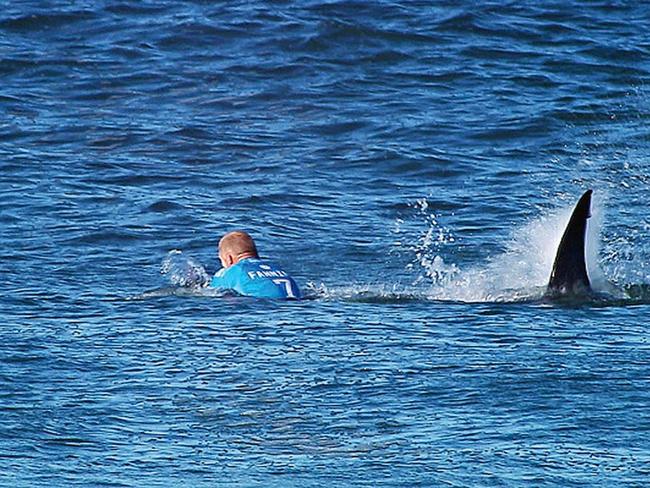
The YouTube clip has been watched more than 23 million times; Fanning on the Jetski, giving Wilson a thumbs-up, then on his haunches, shaken, but only scratched, somehow, looking at his leg rope which was still strapped to his ankle, but there was no board at the other end.
Yeah, that just happened. Fanning was attacked by a shark, live on TV.
Everyone was stunned, but alive. The final was called off. There was no official J-Bay winner in 2015. But it’s fair to say Fanning had a victory of sorts.
It was the story of the year, for a few weeks, and after most were done chasing Fanning’s miraculous tale, the world moved on.
Twelve months later, and Fanning — without an “agenda” this year after a period which not only included a shark attack, but also the death of his brother, Peter, and a parting of ways with his wife of seven years, Karissa Dalton — is looking at those good blobs headed to J-Bay. He was already going back, July circled on his calendar, having recommitted to the J-Bay Open as one of the few events he would surf to ensure he remains qualified for the tour in 2017, when he goes fulltime again, maybe.
It was his commitment to the event, and that of Wilson, during meetings between World Surf League officials and the surfers in the wake of the attack, which determined everyone would go back to Supertubes.

He was back in the water surfing a week after the attack, away from South Africa. But while he had committed to getting back in the water at J-Bay, he still had to do it.
Now the blobs were getting there a week or so before the event actually began. Fanning wanted a surf, so he bought a plane ticket.
“I just wanted to come and surf,” a relaxed and buoyant Fanning said after scoring a victory in his first heat back in competition at J-Bay.
The sun was peeking through the clouds, coming out as he entered the surf, but it was cold. He was draped in a RipCurl poncho-style towel, and was completely relaxed about being back in the same waves in which he went toe-to-toe with a great white.
“I was looking for somewhere in Australia at first, then I saw these big old blobs coming to J-Bay and I was like: ‘Let’s go’.
“I just thought we’ll come over and surf with no one around.”
There’s a “little perch” just outside the beach house Fanning stays in at J-Bay which he stands on to survey the swell.
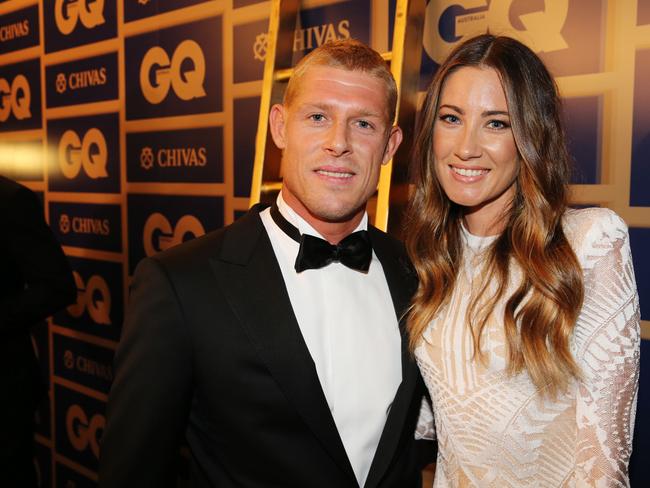
His digs are surrounded by other houses, with names like Beach Music and Shaloha and Dreamland. It’s like a commune setting, all opening on to each other, no fences. Only the houses are rather opulent. They are two and three storeys each, modern, with balconies to check out the waves, linked by open grassed areas which feed surfers to the point break below.
Most are empty in July. The wave continues to break but the wind turns cold. Even South Africa has a winter.
The only ones brave enough to turn out in J-Bay in June and July are the locals, and then the professionals who arrive en masse for the annual event.
Not many had paid attention to the blobs like Fanning. So when he arrived to the enclave of idyllically named accommodation houses, there weren’t many people around.
It had worked out that he could get back in the water, if he could, without much fanfare.
His return to the surf was initially delayed, the blobs hadn’t yet produced the waves they promised, so he and Corey Wilson, who had tagged along to document his mate’s return, did the shopping. They “got settled”. But you can’t stay where they are and not see the swell, or hear it, breaking again and again. The surfer’s siren song. It might not have been big, but Fanning knew he had to go in.
“We just stood up there after brekkie and had a look. I probably shouldn’t have had so much coffee before it,” Fanning said, laughing as he recalled how nervous he was. He said his hands were shaking, but that could have been the caffeine.
“We just stood and looked, more checking out the waves. I saw the spot where it happened, and the memories came back a little bit. I was a little bit anxious, to be honest, a bit nervous. But the waves were small. Then in the afternoon I was like, let’s just go out. It was like building up for a heat, it was so tense. It was pretty funny.
“Corey was more nervous than I was. Then we went out, and after the first wave, I was fine, I started to get moving, and it went from there.”
Wilson said there was a “crazy energy” in the house before that first surf. They both knew it was a big moment.
“We were hanging in his room and I had to go downstairs because the mood was so tense,” Wilson said.
“Then when he joined me downstairs, he realised how weird the vibe got and we had a good laugh about it.
“He ripped the s — t out of the first wave … and by the end it was like nothing had ever happened.”
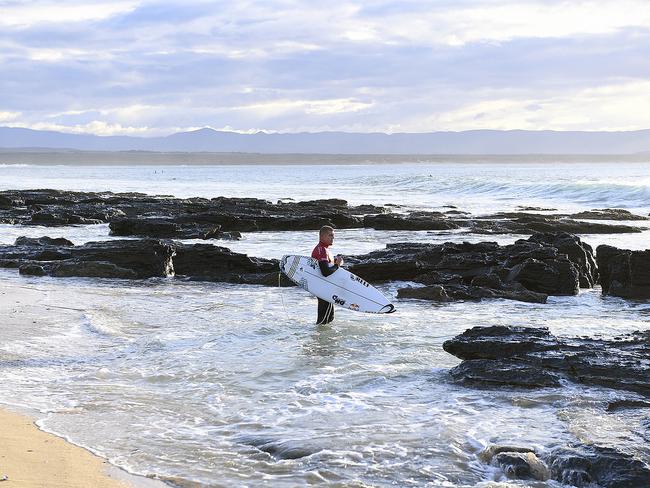
It was just like Fanning to add another layer of drama because the next day he injured his ankle. There were initial fears he wouldn’t be ready for the event, and his comeback surf would be limited to his own memories.
He said he endured “torture” watching the wave he loves roll in while he rested up. But he did what he had to, so the world could enjoy his J-Bay return, too.
IN a few pre-event interviews and the odd social media post after his arrival back in J-Bay, there was an observable absence of one particular word. Shark.
Fanning referred to his attack as “what happened” more often than not. No point giving the shark undue airplay.
It seems less deliberate and more unconscious, especially when Fanning recalls his memories of “what happened”.
“I don’t really go through the memories of what I saw — I look at the vision, go for more from an outside point of view. What everyone else saw I saw,” he said.
Everyone didn’t see everything, though. Like that 10 seconds behind the wave, when no one could see anything.

“Well, the shark hit me first, and knocked me off my board, you can see that. Then it actually came back around and bumped me again,” Fanning said.
“The last thing I saw was my board on the back of it sailing out in to the sunset and I was like, ‘OK, I’m out of here.’
“I started swimming and got 20 strokes in and thought, ‘Hang on, if this thing’s going to eat me I might as well go down with a fight’. I had a lot of things go through my head.
“That’s … you know, I don’t really like going in to it that much.”
That’s fine, but just one more quick question — did you punch the shark?
“I didn’t really punch it, man, I was just trying to get away from it,” he said, amused by the thought of punching a shark, an idea perpetuated by memes that flooded social media as Fanning’s fight with the shark went viral.
“Those things are so big and so powerful, they dictate what they want to do.
“I was just doing my best to get away. I wanted to be Jesus and run on water at the time, but you can’t do that.”
No, you can’t, nor can any of his fellow surfers who could, at any given time, in any event, find themselves in the same situation.
Their place of work is a shark’s home.
Surfers know that, and as Fanning said: “It’s the ocean, things happen, and you can’t put a cage on J-Bay.”
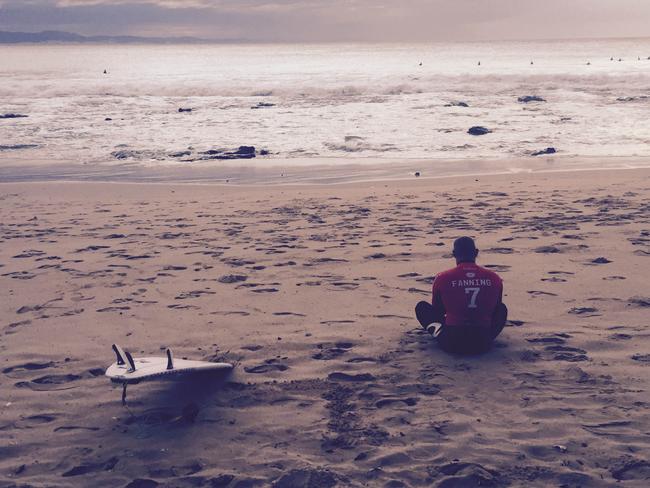
But preventive measures were increased, significantly too, by WSL officials after the Fanning attack.
Commissioner Kieran Perrow conceded it was a wake-up call, and while they had never underrated safety, they also knew they had to do more.
“It was more us getting on the front foot quickly after it happened, and a year comes around pretty fast, and we didn’t want to just be ready for J-Bay, we wanted to be ready across the world,” Perrow said.
Shark activity has increased everywhere, and as a result, technology has been developing to combat their presence around surfers and swimmers.
There are leg ropes with magnetic technology which tests showed conclusively repelled sharks, although not great whites, like the one which attacked Fanning.
They are made by an Australian company, as are the sonar shark detecting buoys deployed in the water at J-Bay.
“It’s impossible to say we are fool proof,” Perrow said.
“The sonar is not a barrier, it’s not going to send them off scuttling in the opposite direction. But that combined with everything else, aerial surveillance, extra Jetskis in the water, we can hopefully see what’s happening. We are definitely in a better place.
“But we are still dealing with the ocean and there is so much that can happen.”
Which is why Fanning’s decision to not just get in the water again, but to return to J-Bay, meant so much to so many.
He had to be comfortable getting back in the water there for everyone else to be.
And he was, and strongly so. Even before he made the decision to not surf the full tour this year, Fanning was committed to returning to J-Bay, so the event did too.
“He was at the meeting we had with the surfers, and Julian (Wilson) as well,” Perrow said.
“And it was fairly unanimous in that, especially when Mick, the main person affected, was sitting there saying: ‘We should go back’.

“And he said he’d go if we held the event again. At that point I’m not sure if he knew he would take a year off. But he was committed to J-Bay at that point and he has followed through.”
Joel Parkinson, himself a world champion and a close friend of Fanning, wasn’t immediately confident his mate would get back in the water at all, let alone return to
J-Bay.
Parkinson was among the highly emotional crew who, in the hours after the attack, shed tears about how close Fanning came to, you know.
“It was way more of a challenge for him to go back in the water, which he did straight away, about a week later, to coming back here and surf J-Bay,” Parkinson said.
“If he hadn’t come back we would have totally understood. We would have come back. But I would have been totally fine if he never came back. But he is such a warrior; it was so good to see him do it.”
Fanning hardly considers himself a warrior, and in fact said the whole experience gave him a softer perspective.
“For me, the difference was just giving the people that I love more time,” he said of his outlook now.
“If I have to sacrifice my time, that’s fine. I just wanted to show these people that I do love them, and making sure they know I am there if they ever need me as well.”
That’s the thing about Fanning — the shark attacked him, and his takeaway is to think more about others.
Parkinson sees that every day, which makes him love Fanning even more.
“It took a big toll on him, the shark, his brother. But he still seems to think of everyone else before himself,” he said
“Sometimes I wish, as his mate, that he would just take some time for himself … to go out and enjoy himself.

“He’s done the hard yards, even more so now. And deserves to look after himself for a bit.”
A double-rainbow broke over J-Bay the same day Fanning returned to the competitive waters.
He easily won his first heat over a couple of youngsters who, despite the old bloke’s relative absence from the tour, still has what it takes. It only took three waves.
Fanning got special attention from the announcer, left until last for introductions, and given a “with huge respect” addition when his name was called out.
Everyone knew it was a big deal that he was back, but they didn’t make that big a deal about it.
“Mick handled it really well coming back, which helped everyone around him handle it well. He’s been fine, which makes it kind of a chain reaction for everyone,” Parkinson said. “That’s testament to the kind of person he is, he’s a calming guy, and he’s so happy to be back.
“And it didn’t happen to anyone else, it happened to him, so if he’s fine with it, I feel I should be too.
“It will never be forgotten but we have to move on.”
Julian Wilson moved on the next day. He sat on his balcony at J-Bay last year, thought about what he’d seen, then saw the waves rolling in.
“And I knew there was no chance I was never coming back,” he said.
He’ll remember his close encounter “for the rest of my life for sure” and says he took strength from seeing how brave Fanning was, and is, by coming back himself.
“I know we both have unfinished business with the wave,” Wilson said.
But different unfinished business.
“If I win, awesome,” Fanning said. “But the main thing is, I came back.”


